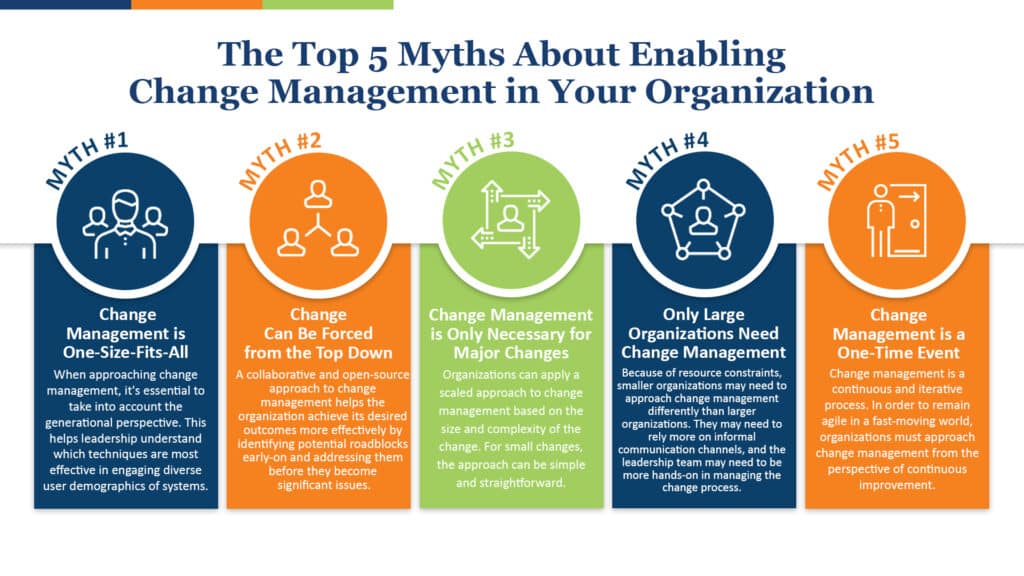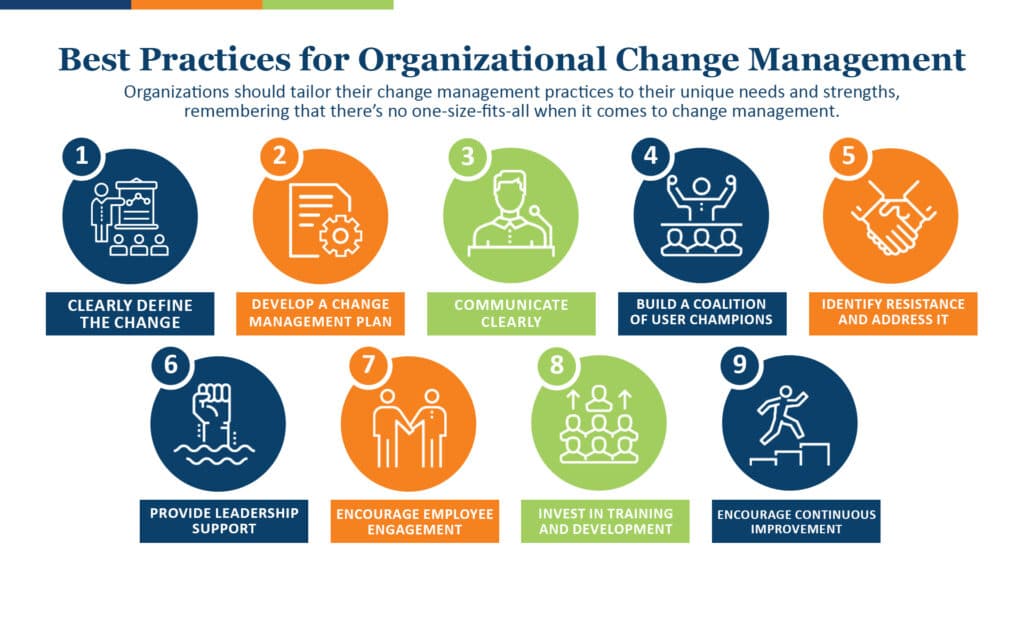The Top 5 Myths About Enabling Change Management in Your Organization
There are a few myths about organizational change management floating around that can do more harm than good. Learn More!
Implementing effective change management can be the difference between surviving and thriving for organizations.
Change management is a crucial component of any organization. When change is managed correctly, you can experience the adoption of new processes, technology, and systems that propel a business forward.
But there are a few myths about organizational change floating around that can do more harm than good. Buying into these myths can slow innovation, put a damper on morale, and hinder your ability to grow and thrive.
In this article, we dive deep into each of these myths, sharing exactly how to identify them and how they could impact your organization. Read on to learn what to do to start seeing meaningful change in your organization.

The first myth suggests that there’s a one-size-fits-all approach to organizational change management (OCM). Some organizations believe in a universal OCM strategy that can be implemented in all companies, regardless of size, industry, or user demographics.
Velosio’s Change Management expert, Jackie Siemens, disagrees.
Every organization is unique, especially when it comes to user demographics. User demographics refer to the age, gender, culture, and technical experience of people within an organization. These demographics can significantly impact how change management is approached.
Different demographics may bring preconceived biases to the table. These biases need to be taken into account when planning how to implement change management practices. For example, let’s say a new change requires user guides to be developed. If the demographic consists of Baby Boomers, they are more likely to rely on printed user guides rather than digital ones.
Alternatively, if the user base is made up of Millennials, these users are old enough to remember a time without modern technology. However, they can be taught how to use modern technology since that was characteristic of their generation. On the other hand, Gen Z users rely solely on modern technology to ease the learning curve and won’t be receptive to printed user guides.
When approaching change management, it’s essential to take into account the generational perspective. This helps leadership understand which techniques are most effective in engaging diverse user demographics of systems. This impacts decisions such as what communications mediums to use and what content types are best suited to a specific audience.
Understanding learning styles is also key to creating a tailored strategy. Users can vary between being auditory, visual, or physical learners. Knowing learning styles can help leaders target change management initiatives. By using a variety of learning tools such as infographics and short videos, in addition to email, organizations can help their user base adapt to change.
The second myth suggests that change is forced from the top down. In other words, only leadership can initiate change. Though this may work in some organizations, a top-down approach to change management is usually short-lived and unsustainable.
A top-down approach to change management can lead to resistance among workers and other management. Top-down approaches also contribute to organizational inefficiencies due to the lack of accountability and buy-in from workers. Top-down change management ultimately hinders the success of change initiatives.
Instead, organizations should consider an open-source change approach. The open-source change incorporates input from people throughout an organization that will be impacted by the change. This leverages the perspectives and talents of all levels to build out the change. By adopting open-source changes, more people can participate in and be influenced by the change.
While open-source change does require a lot of organization, it removes some of the resistance many people feel toward change. Involving employees in the planning, implementation, and evaluation of the change process ensures their voices are heard, builds buy-in, and creates a sense of ownership.
A collaborative and open-source approach to change management also helps the organization achieve its desired outcomes more effectively by identifying potential roadblocks early on and addressing them before they become significant issues.
Some organizations think that change management is only needed when making significant changes, such as implementing a new system or restructuring the company. But change management can be implemented in a variety of circumstances, not just during big organizational changes.
Organizations experience change frequently. Whether it’s small process improvements or minor adjustments to a team. Although smaller in scale, these minor changes can still have a significant impact on an organization, particularly if they affect multiple departments or teams. Regardless of size, when change isn’t managed properly, confusion, frustration, and decreased productivity can occur.
It’s essential to apply change management principles to every change, regardless of size. Organizations can apply a scaled approach to change management based on the size and complexity of the change. For small changes, the approach can be simpler.
Larger changes may require a more comprehensive strategy. Applying change management principles consistently can help organizations build a culture that is more receptive to change.
It sends a message to employees that change isn’t something to be feared, rather it’s a necessary part of growth and development. By treating every change with the same level of attention and care, organizations can create a culture that is more open to innovation and continuous improvement.
Organizations of all sizes benefit from change management. Small organizations may have fewer resources to put towards change management, but it’s still an important aspect of effective change adoption. Because of these resource constraints, smaller organizations may need to approach change management differently than larger organizations.
While large organizations might have a team or department dedicated to change management, smaller organizations may only have one or two people who can dedicate time to change management.
However, this doesn’t mean small organizations don’t need change management. In fact, small organizations are often more vulnerable to the impacts of change because they may have limited resources, less redundancy, and less capacity to absorb shocks.
They may need to rely more on informal communication channels, and the leadership team may need to be more hands-on in managing the change process. But the principles of change management remain the same—regardless of the organization’s size.
Change management is a continuous and iterative process. It can take time for an organization to fully adjust to new systems, technology, or processes. Even after training staff, it’s common for users to backtrack or slide into previous habits.
Sometimes users need to ‘see it to believe it’, especially if they’re skeptical of the shiny promises that come with change. A key aspect to successful key management is receiving feedback from users and keeping an open line of communication between leadership and staff.
Doing so can assure users that changes can be made to newly implemented processes or systems, especially if they’ll help the organization be more efficient.
In order to remain agile in a fast-moving world, organizations must approach change management from the perspective of continuous improvement.
To implement change management successfully, organizations should consider these best practices:

Change management is a crucial component of every organization, regardless of size, user demographics, or organizational structure. Organizations should tailor their change management practices to their unique needs and strengths, remembering that there’s no one-size-fits-all when it comes to change management. Reach out to Velosio today to learn more on change management methods and myths.
Talk to us about how Velosio can help you realize business value faster with end-to-end solutions and cloud services.
"*" indicates required fields